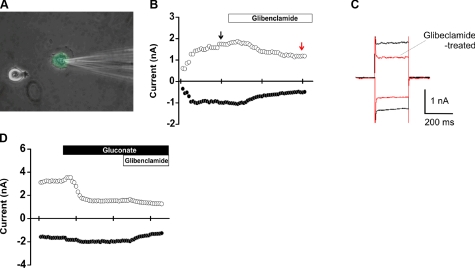Figure 5.
Electrophysiological measurements of CFTR activity in hMSC/NHBE heterokaryons. A) GFP-positive heterokaryon with electrode (patched). Note the presence of 2 nuclei and round epithelial morphology. B, C) Glibenclamide (100 uM) inhibits CFTR activity in a heterokaryon (decrease; red arrow). Outward and inward currents were both decreased (C) after the addition of glibenclamide in the presence of BaCl2 (5 mM). D) Decrease in inward Cl− movement through CFTR after change of bath solution from NaCl to Na-gluconate. Note that all glibenclamide treatments were made in the presence of BaCl2.

